- Home
- Peter Matthiessen
Sal Si Puedes (Escape if You Can) Page 7
Sal Si Puedes (Escape if You Can) Read online
Page 7
“We’ve planted a lot of trees. Elms, mostly, and Modesto ash—only the cheapest kinds.” Chavez stood with his back to the road, hands in hip pockets, gazing with pleasure at the desolation. The Forty Acres lies between the state road and the city dump. Useless for farming in its present condition, the property was obtained in 1966 from a widow who could not afford to pay the taxes on it. “Don’t get me started on my plans,” he said. To Chavez, who envisions the first migrant workers center, the place is already beautiful; he comes here regularly to walk around and let his plans take shape. “There’s alkali in this land,” he said. “We’re trying to get something growing here, to cut down the dust.”
At the Forty Acres, near the highway, an adobe building which will house gas pumps, auto repair shop and a cooperative store had recently been completed, though it was not yet in use: the shop was heaped high with food stores for the strikers, donated by individuals and agencies all over the United States. Just across from it is the windowless small room in which Chavez lived during the twenty-five-day fast that he undertook in February and March 1968. Behind this building was a temporary aggregation of shacks and trailers which included the workers clinic and the Union newspaper, El Malcriado (the “rebellious child,” the “nonconformist,” the “protester”—there is no simple translation), which issues both English and Spanish editions every fortnight. Originally El Malcriado was a propaganda organ, shrill and simplistic: it saw Lyndon Johnson as a “Texas grower” careless of the lives of the Vietnamese “farm workers.” Today it is slanted but not irresponsible, and it is well-edited.
One green trailer at the Forty Acres, bearing the legend MOBILE HEALTH CENTER, was the contribution of the International Ladies’ Garment Workers Union; its medical staff, like that of El Malcriado and most of the rest of the UFWOC operation, is made up entirely of volunteers. So is the intermittent labor being done on the headquarters building, a gray shell in the northwest corner of the property. The work was supervised by Chavez’s brother Richard, who had been sent off a few days before to help out with the boycott in New York. “The strike is the important thing,” Chavez said, moving toward this building. “We work on the Forty Acres when we get a little money, or some volunteers.” The day before, six carpenters from a local in Bakersfield had given their Saturday to putting up gray fiberboard interior walls, and Chavez, entering the building, was delighted with the progress. “Look at that!” he kept saying. “Those guys really went to town!” The plumbing had been done by a teacher at Berkeley, and two weeks before, forty-seven electricians from Los Angeles, donating materials as well as labor, had wired the whole building in six hours. “I’ve never seen forty-seven electricians,” I admitted, trying not to laugh, and Chavez grinned. “You should have seen it,” he assured me. “I could hardly get into the building. Everywhere I went, I was in somebody’s way, so I just went out through the window.”
The building will combine Union offices and a service center, where workers can obtain advice on legal problems, immigration, driver’s licenses, tax returns, and other matters. We inspected the credit union, legal offices, the hiring hall-and-auditorium, the dining hall, kitchen and rest rooms.
In the northeast corner were small cubicles for the Union officers. “Everybody was out here claiming his office.” Chavez smiled, shaking his head. “We’ve outgrown this building even before we move into it, and I guess they thought that somebody was going to get left out.” He grunted. “They were right.” We had come to the cubicle in the corner. “This is mine, I guess,” he said, “but now they don’t want me here.” I asked why. He was silent for a little while, looking restlessly about him. “I don’t know.” He shrugged and took a breath, as if on the point of saying something painful. “They’re very worried about security or something. I don’t know.” Stupidly, I failed to drop the subject. “I guess the corner is more exposed,” I said. “They want you somewhere inside.”
Chavez walked away from me. “This is the conference room,” he called, from around a corner. “This will save a lot of time. People are constantly coming in, you know . . . ” His voice trailed off, resumed again. “The way things are going, we don’t have enough office space for the newspaper or the ranch committees . . . Oh! Look at that!” He was turning a complete circle. “Those guys really went to town! It’s entirely changed!” He finished his circle, beaming. “The first center for farm workers in history!” (A year later Richard Chavez took me out to see the progress at the Forty Acres, which was negligible. “We’re so damn busy,” Richard said, “and there’s always something that needs the money more.”)
Outside again, we walked around the grounds, in the hot emptiness of Sunday. “Over there”—he pointed—“will be another building, a little training center there, kind of a . . . a study center for nonviolence, mostly for people in the Union, the organizers and ranch committees. Nonviolent tactics, you know—to be nonviolent in a monastery is one thing, but being nonviolent in a struggle for justice is another. And we’ll stress honesty. Some of these guys will be getting a lot of power as the Union develops, and some will be very good and some won’t know how to handle it. If someone in the hiring hall is willing to take a bribe to put one guy ahead of another on a job, he may also be willing to steal a hundred dollars from the Union, or accept a hundred dollars for an act of violence. There’s all kinds of chances for corruption, and things can go to hell fast—we’ve seen that in other unions. So the best way to teach them is by example.”
His glance asked that I take what he was about to say as nothing boastful. Chavez is a plain-spoken man who does not waste his own time or his listener’s with false humility, yet he is uncomfortable when the necessity arises to speak about himself, and may even emit a gentle groan. “I mean, you can write a million pamphlets on honesty, you can write books on it, and manuals, and it doesn’t work—it only works by example. I have to give up a lot of things, because I can’t ask people to sacrifice if I won’t sacrifice myself.” He was glad to change the subject. “We have some great guys in this Union, some really great guys. We’ve put together farm workers and volunteers, people who just wanted to do something for the cause. We have so many volunteers that we save only the best; they come and go, but the good ones never go. You don’t say ‘Stay!’ They stay of their own accord!
“In a way we’re all volunteers; even the ones—the lawyers and everybody—whose salaries are paid by outside people; they’re not making money. You start paying the strikers for what they should do for themselves, then everything is done for money, and you’ll never be able to build anything. It’s not just a question of spending money, and anyway, we haven’t got it. But the farm workers stand to benefit directly from the Union; it’s their union, and we’ve been able to get that across to them—really, you know, it’s working beautifully. Most of us work for five dollars a week. Outside people, the Teamsters and everybody, thought we were crazy, but it’s the only way we can stay in business. It’s a long, long haul, and there isn’t any money, and if we start paying wages, then it means that only a few can be hired, and a few can’t do as much as many.
“It has to be done this way. I’ve been in this fight too long, almost twenty years, learning and learning, one defeat after another, always frustration. And then of course, raising a family—you have to get your family to suffer along with you, otherwise you can’t do it. But finally we’re beginning to see daylight, and that’s a great reward. And then, you see, these farm workers will never be the same. If they destroyed our union today, these people would never go back to where they were. They’d get up and fight. That’s the real change.”
Under the eaves of the garage, in the shade of the north wall, a blue wooden bench stood against the adobe. We sat there for an hour or more, cut off by the cool clay walls from the howl of the highway. To the west was a marginal dark farm—all dying farms look dark—with a lone black-and-white cow in the barnyard, and a sign, itself in need of repair, that advertised the repair of auto radiators. A
cross the property to the north, dead cars glittered on the crown of the city dump; heaped high like a bright monument to progress, the cars form the only rise in the depressed landscape of Delano.
The adobe walls and red tile roofs of the Forty Acres were Chavez’s own wish, to be repeated in the other buildings as they take shape: the idea comes from the old Franciscan missions, and from an adobe farmhouse of his childhood. “The people wanted something more modern—you know, kind of flashy—to show that they had a terrific union going here, but I wanted something that would not go out of fashion, something that would last.” Eventually the entire Forty Acres will be surrounded by a high adobe wall, which will mercifully shut out its grim surroundings. The flat hard sky will be broken by trees, and he dreams of a fountain in a sunken garden, and a central plaza where no cars will be permitted.
Chavez drew his hopes in the old dust with a dead stick. Inside the walls, paths will lead everywhere, and “places for the workers to rest. There will be little hollows in the walls—you know, niches—where people can put little statues if they want, or birds and things. We’ll have frescoes. Siqueiros is interested in doing that, I think. This place is for the people, it has to grow naturally out of their needs.” He smiled. “It will be kind of a religious place, very restful, quiet. It’s going to be nice here.” He gazed about him. “I love doing this—just letting it grow by itself. Trees. We’ll have a little woods.” Arizona cypress had already been planted along the property lines, but in the August heat many of Chavez’s seedling trees had yellowed and died.
Car tires whined to a halt on the highway and crunched onto the flats of the Forty Acres. Chavez became silent; he sat stone-still against the wall, gazing straight out toward the glistening dump. When the car came past the corner of the building into his line of sight, he smiled. The driver was Ann Israel of the Spectemur Agendo Foundation of New York, who had introduced us originally. We all waved. “I heard you were out here,” she called. “Do you want a lift back into town?”
Chavez shook his head. “That’s all right, thanks,” he said. “We can walk.” For a moment Mrs. Israel looked as astonished as I felt—not so much that the walk back was a long one on the hot August highway but that Chavez felt relaxed enough to take the time away. But the day before, in Bakersfield, he had won a crucial skirmish with the growers; though he gives an almost invariable impression of great calm, he was more relaxed this morning than I had ever seen him. After a week’s immersion in injunctions, boycotts, restraining orders, suits and strikes, he seemed glad to talk about trees and red-tiled missions, and to remain seated peacefully in the shade of his adobe wall, on a blue wooden bench.
Mrs. Israel perceived this instantly and made no effort to persuade him to accept a ride. Chavez smiled fondly after her as she waved and drove away. A pretty girl in her thirties, Mrs. Israel is both tough-minded and kind, and she has been a good friend to the farm workers, finding support for them in other foundations besides her own. In June she had got me to edit an outline of insecticide abuses for possible use in a farm workers’ ad, thus transforming my vague endorsement of the California grape strike into active participation. At that time she also told me that she was going to Delano in midsummer, to see at first hand what her foundation was considering supporting; if I cared to come along, she said, she would introduce me to Cesar Chavez.
Because he is such an unpublic man, Chavez is one of the few public figures that I would go ten steps out of my way to meet. Besides, I feel that the farm workers’ plight is related to all of America’s most serious afflictions: racism, poverty, environmental pollution, and urban crowding and decay—all of these compounded by the waste of war.
In a damaged human habitat, all problems merge. For example, noise, crowding and smog poisoning are notorious causes of human irritability; that crowded ghettos explode first in the worst smog areas of America is no coincidence at all. And although no connection has been established between overcrowding and the atmosphere of assassination, rat experiments leave little doubt that a connection could exist: even when ample food and shelter are provided, rats (which exhibit behavioral patterns disconcertingly similar to those of man) respond to crowding in strange and morbid ways, including neuter behavior, increased incidence of homosexuality, gang rape, killing, and consumption by the mothers of their young. But because the symptoms of a damaged habitat are social, a very serious problem of ecology (it seems fatuous to say “the most serious problem the world has ever known,” not because it is untrue but because it is so obvious) will be dealt with by politicians, the compromisers and consensus men who do not lead but merely exploit the status quo. The apparatus of the status quo—the System is a partisan term but must do here for want of a better—not to speak of System ethics, is not going to be good enough when food, oxygen and water become scarce. Although it seems likely, in purely material needs, that the optimisms of the new technologies will be borne out, most men in 1985 will have to live by bread alone, and not very good bread, either. Famine is already as close as Kentucky and the Mississippi Delta, and apart from that, there is hard evidence of environmental stress—noise, traffic, waiting lines, sick cities, crime, lost countrysides, psychosis. Meanwhile, the waste of resources continues, and the contamination of the biosphere by bomb and blight.
Before this century is done, there will be an evolution in our values and the values of human society, not because man has become more civilized but because, on a blighted earth, he will have no choice. This evolution—actually a revolution whose violence will depend on the violence with which it is met—must aim at an order of things that treats man and his habitat with respect; the new order, grounded in human ecology, will have humanity as its purpose and the economy as its tool, thus reversing the present order of the System. Such hope as there is of orderly change depends on men like Cesar Chavez, who, of all leaders now in sight, best represents the rising generations. He is an idealist unhampered by ideology, an activist with a near-mystic vision, a militant with a dedication to nonviolence, and he stands free of the political machinery that the election year 1968 made not only disreputable but irrelevant.
In the heavy Sunday silence of the Valley we rose from the bench, stretched, grinned and went back out into the sun. Ten o’clock had come and gone, and the blue sky had paled to a blue-white. We walked toward town in silence. In the corner of Forty Acres, just off the highway, was a heavy wooden cross with ten-foot arms, made of old telephone poles, which had been consecrated at the time of the February fast; after Senator Kennedy’s assassination it had been covered with a shroud. In late June, following two attempts to burn it, local vigilantes sawed it down. The charred remnants were left there in the mesquite desert dust so that no one on either side would forget the event. Chavez glanced at the despoiled cross but made no comment.
Our shoes scuffed along the highway shoulder, over the slag of broken stone, tar bits, glass and flattened beer cans—Hamm’s, Olympia, Coors. In the still heat, tar stink and exhaust fumes hung heavy in the air. Exhaust filters were first required by law in California, where air pollution is so pervasive that the whole state seems threatened by a dull gray-yellow pall; it is appropriate that Chavez’s fight for a new ethic should have begun in California, which free enterprise has reduced from the most majestic of the states to the most despoiled.
Of all California’s blighted regions, the one that man has altered most is this great Central Valley, which extends north and south for almost four hundred miles. The Sacramento Valley, in the northern half, was once a sea of grass parted by rivers; the San Joaquin Valley, in the south, was a region of shallow lakes and tule marshes. Both parts of what is commonly known as the Valley supported innumerable animals and birds, among which the waterfowl, antelope and tule elk were only the most dominant; there were also wolves, grizzlies, cougar, deer and beaver. To the Spanish, centered in the great mission holdings along the south-central coast, the grasslands of the interior were scarcely known, and their destruction was acco
mplished almost entirely by the wave of Americans that followed hard upon the Gold Rush. Game slaughter became an industry, and the carnivores were poisoned; by 1875 the myriad elk and antelope were almost gone. Meanwhile, unrestricted grazing by huge livestock herds destroyed the perennial grasses. Oat grass, June grass and wild rye gave way to tarweed, cheat grass and thistle, which in turn were crowded by rank annual weeds escaped from imported food crops of the settlers. In landscape after landscape, the poppies, lupines, larkspurs and mariposa lilies were no more.
From the start, California land monopolies were so enormous that the big “farms” were not farms at all, but industrial plantations. (To this day, the Kern County Land Company owns 350,000 acres in Kern County alone.) In the latter part of the nineteenth century, the huge corporate ranches were challenged for the dying range by huge corporate farms; the first big factory crop was wheat, the second sugar beets. One by one the tule marshes were burned over and drained; by the end of the century, the lakes and creeks, like the wild creatures, had subsided without a trace. As the whole Valley dried, the water table that once had lain just below the surface sank away; in places, the competitive search for water made it necessary to resort to oil-drilling equipment, tapping Ice Age aquifers hundreds of feet down. To replace the once plentiful water, the rivers were dammed and rechanneled in the Bureau of Reclamation’s Central Valley Project, begun in the thirties: Shasta Dam destroyed the Sacramento, and Friant Dam choked off the San Joaquin. Today there are no wild rivers in the Valley, and very few in all of California; the streams of the Coast Range and the Sierra Nevada have been turned to irrigation, seeping across the Valley floor in concrete ditches.

 Lost Man's River: Shadow Country Trilogy
Lost Man's River: Shadow Country Trilogy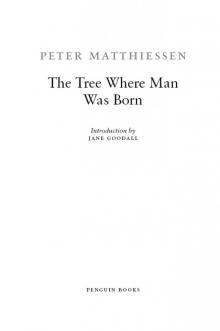 The Tree Where Man Was Born
The Tree Where Man Was Born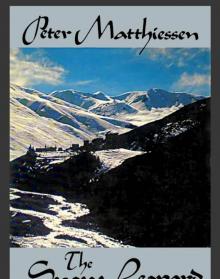 The Snow leopard
The Snow leopard Sand Rivers
Sand Rivers The Cloud Forest
The Cloud Forest Sal Si Puedes (Escape if You Can)
Sal Si Puedes (Escape if You Can) Far Tortuga
Far Tortuga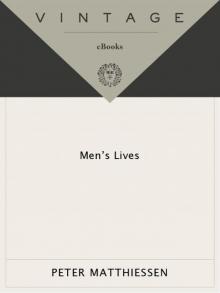 Men's Lives
Men's Lives On the River Styx: And Other Stories
On the River Styx: And Other Stories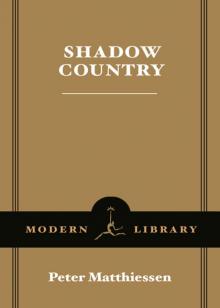 Shadow Country
Shadow Country At Play in the Fields of the Lord
At Play in the Fields of the Lord Lost Man's River
Lost Man's River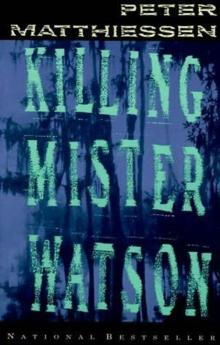 Killing Mister Watson
Killing Mister Watson On the River Styx
On the River Styx